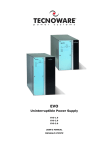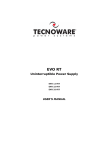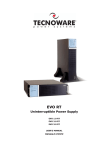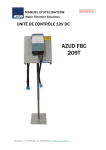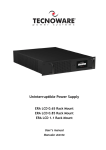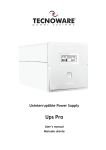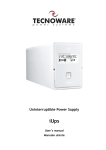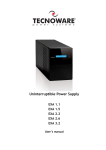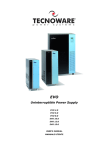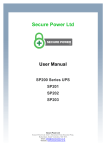Download Tecnoware FGCEVO3 uninterruptible power supply (UPS)
Transcript
EVO Uninterruptible Power Supply EVO 1.0 EVO 2.0 EVO 3.0 USER’S MANUAL 11 INDEX SECURITY NOTICE page 2 INTRODUCTION page 3 UPS EVO 1 MAIN CHARACTERISTICS page 4 2 EXTERNAL DESCRIPTION page 5 page 8 FRONT PANEL REAR SIDE 3 RUNNING OPERATIONS SWITCHING ON LINE MODE BATTERY MODE LOW BATTERY AND AUTOMATIC RESTART LOAD TEST 4 INSTALLATION INSTRUCTIONS page 11 RECEIPT OF UPS PLACEMENT FIRST START UP 5 COMPUTER INTERFACE page 12 6 TECHNICAL CHARACTERISTICS page 13 7 SUGGESTIONS FOR A CORRECT USE page 14 MAINTENANCE BATTERY MAINTENANCE SAFETY FOR THE OPERATOR 8 ANOMALIES AND TROUBLESHOOTING page 15 9 FIGURES page 17 © Copyright 2006 TECNOWARE s.r.l. All rights reserved. All trademark are property of their respective owners. TECNOWARE s.r.l. www.service.tecnoware.com This manual has been printed and edited by TECNOWARE s.r.l. November 2006 Edition version 3.0 User’s manual 1 UPS EVO 11 SECURITY NOTICE Read this manual carefully before installing and using TECNOWARE EVO Uninterruptible Power Supply, which will be referred to as UPS from hereafter. The UPS must be used only by properly trained personnel. To ensure correct and safe operation, it is necessary that operators and maintenance personnel observe the general Safety Standards as well as the specific instructions included in this manual. Risk of electric shock: do not remove the cover. The UPS contains internal parts which are at a high voltage and are potentially dangerous, capable of causing injury or death by electric shock. There are no internal parts in the UPS that can be repaired by the user. Any repair or maintenance must be performed exclusively by qualified technical personnel authorized by TECNOWARE. TECNOWARE declines any responsibility if this warning is disregarded. It is compulsory to ground the UPS according to Safety Standards. Risk of electric shock at the output socket when the UPS is ON. Risk of electric shock at the output socket while the unit is connected to the AC utility line. Use the input power cable given with the unit and connect it to the AC utility line. In all circumstances a (H05VVF3G 1,5mm²) cable or a better one must be used. Do not obstruct ventilation slots or holes and do not place any object on top of UPS. Do not insert objects or pour liquids in the ventilation holes. Do not keep liquids, flammable gases or corrosive substances near the UPS. Install the UPS environment. UPS EVO indoors, in a protected, 2 clean and moisture-free User’s manual 11 INTRODUCTION UPS EVO UPS EVO (Uninterruptible Power Supplies) are the result of constant technological research aimed at obtaining the best performance at the lowest cost. UPS EVO are advanced ON-LINE UPS, single-phase, built specifically to protect your computer from any irregularities in the AC line (for example blackouts, brownouts, overvoltages, microinterruptions) which often cause damage to hardware and software. During a power failure, EVO continues supplying adequate AC power (with a true sinewave) to all connected devices by its internal battery and by its DC/AC converter (Inverter). Under normal AC line condition, EVO provides an automatic output voltage regulation by the Rectifier and Inverter blocks and filters out frequently occurring electrical disturbances (high voltage transients, spikes, interferences, etc.), thus protecting the devices connected to its outlets. EVO protects the devices from accidental overload or Inverter fault by an AUTOMATIC BYPASS that directly connects the AC input line with its outlets. EVO is supplied with an RS-232 communication port and USB port, which can be used to signal to a generic processor or computer the absence of mains condition or the end of autonomy condition. This permits to carry out an automatic data saving operation during a long black out with the most spread Operating Systems (Windows, Linux, Novell, etc). Furthermore, the communication ports permit EVO to communicate with the computer, transferring various measurements such as: input output voltage, battery voltage, output power, frequency, and can also be programmed for automatic operations such as switching ON/OFF in a preset time. WARNING Please read this manual before using EVO, because it contains important safety information for the operator in order to carry out a correct use of the unit. This manual is related to the below EVO models: • EV0 1.0 • EV0 2.0 • EV0 3.0 In this manual, the same for all 3 models, EVO will simply be called UPS. EVO is constantly being developed and improved: consequently, your unit may differ somewhat from the description contained in this manual. User’s manual 3 UPS EVO 11 MAIN CHARACTERISTICS EVO offers all the modern characteristics which guarantee maximum reliability and security: • Microprocessor control guarantees high reliability • ON-LINE double technology without transformer • Pure Sinewave • Output voltage regulation +/- 2% • Overload, overheating and short circuit protection • AUTOMATIC BYPASS to protect from accidental overload or Inverter fault • MANUAL BYPASS through switch on the rear side • Switching ON even with no mains condition • Automatic protection in case of discharged batteries • After a shutdown caused by the end of autonomy and when mains condition is restored there is an automatic SWITCHING On operation • Automatic functioning test through a switch • Automatic regulation to the input frequency 50 or 60 Hz • Visual warnings by leds, indicating operational mode and low battery, overload and alarm conditions • Dry contact board (optional) • SNMP Adapter (optional) • EPO (Emergency Power OFF) • Remote ON/OFF • Acoustic signals of various kinds indicating alarm situations • Communication with the computer by a RS-232 Interface and possible monitoring of input/output voltage, frequency, output power, battery voltage, etc. • Automatic turn on/off user-programmable by RS-232 Interface • Protection filter for the telephone, ADSL and data line • Possibility to increase the autonomy through External Battery boxes (optional) • High reliability and high performances • Easy to use UPS EVO 4 User’s manual 12 EXTERNAL DESCRIPTION FRONT PANEL On the front panel there are the control buttons and some leds which indicate the various operating mode and alarm conditions. Please see the figures 1 and 2 OFF button To turn off the UPS, press this button for more than one second. ON/TEST/ALARM button Can be used for 3 functions: • TURN ON: the UPS is turned on by keeping the button continuously pressed for more than 1 second. • SELF-TEST: the UPS performs a SELF-TEST, according to the procedure explained further on, when the button is pressed during LINE mode for more than 1 second. • ALARM OFF: during BATTERY mode, to disable the alarm buzzer, press this button for more than 1 second. LINE led This led (blue) is ON when the input AC line voltage amplitude is within the specification, and it indicates the UPS is working in LINE mode. If LINE led flashes every second it shows that Phase line and Neutral line of AC input utility line are inverted. In that case it must disconnected the AC power input plug from power receptacle, turn it at 180 degrees and plug in the power receptacle again INVERTER led This led (blue) is on when the Inverter is regularly working BATTERY led This led (blue) is on when the UPS is working in BATTERY mode (during a blackout or overvoltage/brownout). BYPASS led This led (blue) is on when the UPS is working in BYPASS mode: the AC input line is connected directly with the UPS outlets. FAULT led This led (red) is turned on whenever the UPS detects a FAULT condition and needs a technical intervention as soon as possible. User’s manual 5 UPS EVO LOAD LEVEL led bar Refer figure 2 – Front Panel. The led bar has 6 leds (5 leds are blue and one led is red). This bar indicates the output power percentage (LOAD LEVEL), proportional to the number of switched on leds. The greater the load the more LED indicators will light on. There are the following LOAD LEVEL percentages: • • • • • 0~20%: only one led is on (led13) 21~40%: two leds are on (led13 and led12) 41~60%: three leds are on (led13, 12 and 11) 61~80%: four leds are on (led13, 12, 11 and 10) 81~100%: five leds are on (led13, 12, 11, 10 and 9) The OVERLOAD red led (led8), is on to warn of an OVERLOAD condition. BAT. LEVEL led bar Refer figure 2 – Front Panel. The led bar has 6 leds (5 leds are blue and one is yellow). This bar indicates the battery capacity percentage (BAT. LEVEL), proportional to the number of switched on leds. The higher the battery capacity the more LED indicators will light on. There are the following battery capacity percentages: • • • • • 100~81%: five leds are on (led15, 16, 17, 18 and 19) 80~61%: four leds are on (led15, 16, 17 and 18) 60~41%: three leds are on (led15, 16 and 17) 40~21%: two leds are on (led15 and led16) 20~0%: only one led is on (led15) The LOW BAT yellow led (led14), is on to warn of a LOW BATTERY condition during BATTERY mode. REAR SIDE The following are located on the rear side (see figure 3): 1) Grounded AC Input power socket: to connect the UPS to AC utility line by the supplied input cord. 2) Input Circuit Breaker: it goes off in overload or short-circuit condition; push the external 3) Grounded output socket: for connecting equipments to be protected. 4) (Only EVO 2.0 and EVO 3.0) Grounded power output socket: for connecting an output power line to supply all the equipments to be protected. 5) RS-232 Computer Interface (female connector 9 poles DB9): it is the interface port (RS-232) to communicate with a computer. 6) RJ11/RJ45 IN/OUT plugs: to protect and filter a phone line, an ADSL or a LAN. 7) Slot for external batteries connector: to connect the UPS to an external Box Battery (optional). 8) Dry contact board / Slot for SNMP adapter (optional). 9) Manual BYPASS switch: to force the UPS into BYPASS mode (see chapter “Running Operations”). 10) Remote ON/OFF contact. 11) EPO (Emergency Power OFF). UPS EVO 6 User’s manual EPO (EMERGENCY POWER OFF) EPO 2 1 Remote Button EPO The EVO models have the EPO (Emergency Power OFF) connector (2 terminals connector) on the rear. This permits to immediately switch the UPS OFF from a distance in case of emergency. To use EPO function is very simple: it is sufficient to connect an external switch to the EPO terminal(see Figure 3 – Rear Side): if the switch is CLOSED the UPS works normally. If on the contrary, the switch is OPEN then the UPS turns OFF immediately. To switch ON the UPS again it is necessary to close the EPO switch and then manually restart the UPS from the front panel. The EPO terminals are isolated and do not need an external feeding voltage. REMOTE ON/OFF ON 1 OFF 2 3 4 Remote Button OFF Remote Button ON The EVO models have remote ON/OFF terminals connector on the rear side (see figure 3), this permits to switch the UPS ON and OFF from a distance. Using the ON/OFF external button (as described in the above picture) the frontal panel button capacity can be used from a distance. Evo is on; pressing the OFF button connected to terminal 1 and 2 for at least 3 seconds, EVO turns OFF. EVO is off; pressing the ON button connected to terminal 4 and 5 for at least 3 seconds, EVO turns ON. The remote ON function is disabled when the UPS is off and the AC input line voltage is not present. User’s manual 7 UPS EVO DRY CONTACTS BOARD (OPTIONAL) Fault Common 1 2 3 4 Bypass 6 5 AC fail 7 8 Low BAT 9 10 The Dry Contact board has a 10 pin connector on the rear side of the UPS. 1. Common Pin 1 and Pin 2 are common pins. 2. Fault Pin 3 is the normal-open output: When UPS works normally, Pin 3 and Pin 1-2 will be open, when UPS is failed, Pin 3 and Pin 1-2 will be closed. Pin 4 is normal-closed output: When UPS works normally, Pin 4 and Pin 1-2 will be closed, when is failed, Pin 4 and Pin 1-2 will be open. 3. Bypass Pin 5 is the normal-open output: When UPS works normally, Pin 5 and Pin 1-2 will be open, when UPS works in bypass mode, Pin 5 and Pin 1-2 will be closed. Pin 6 is normal-closed output: When UPS works normally, Pin 6 and Pin 1-2 will be closed, when UPS works in bypass mode, Pin 6 and Pin 1-2 will be open. 4. AC fail Pin 7 is the normal-open output: When UPS works normally, Pin 7 and Pin 1-2 will be open, when UPS works in AC failure mode, Pin 7 and Pin 1-2 will be closed. Pin 8 is normal-closed output: When UPS works normally, Pin 8 and Pin 1-2 will be closed, when UPS works in AC failure mode, Pin 8 and Pin 1-2 will be open. 5. Low Bat Pin 9 is the normal-open output: When UPS works normally, Pin 9 and Pin 1-2 will be open, when UPS works in battery low voltage mode, Pin 9 and Pin 1-2 will be closed. Pin 10 is normal-closed output: When UPS works normally, Pin 10 and Pin 1-2 will be closed, when UPS works in battery low voltage mode, Pin 10 and Pin 1-2 will be open. The Dry Contact board is OPTIONAL UPS EVO 8 User’s manual 13 RUNNING OPERATIONS SWITCHING ON If the UPS is switched off and connected to the electric line, the LINE Led in the front side is switched on together with the BAT. LEVEL led bar showing batteries capacity level. In these conditions UPS has the only function of recharging batteries and there is no power on the output sockets (switched off output). If it is disconnected from the AC utility line, after some second UPS is switched off completely. The UPS is switched off and connected to the AC utility line (LINE Led and BAT. LEVEL bar are switched on). In order to switch the UPS on, it is sufficient to press continuously for more than 1 second ON/TEST/ALARM button of the front panel till when the UPS emits a short acoustic signal showing its own switching on. The UPS effectuates an initial operating SELF TEST (during which the red FAULT and OVERLOAD leds are switched on), and then activates the power on the output sockets and at the same time it switches on the BYPASS led and the LOAD LEVEL bar (indicating output power percentage); it starts working in BYPASS mode. After some second the BYPASS led is switched off and the INVERTER Led is switched on: all this indicates that UPS has started working normally in LINE mode. If the UPS is not connected to the AC utility line or if the AC utility line is not present due to a blackout, the UPS turns on with a sequence similar to the one described above. Even in this case it needs to press continuously for more than 1 second ON/TEST/ALARM button, till when the UPS emits a short acoustic signal showing its own switching on. The UPS immediately switches on BAT. LEVEL bar, then it effectuates an initial operating SELF TEST (during which the red FAULT and OVERLOAD leds are switched on), it switches on BATTERY Led and after some seconds it activates the power on the output sockets and at the same time it switches on INVERTER led and LOAD LEVEL bar (indicating output power percentage); it starts working normally in BATTERY mode. The UPS automatically returns to function in LINE mode a few seconds after the AC utility line is recovered. To switch the UPS off, press the OFF button for more than 1 second, till when the UPS emits a short acoustic signal showing its own switching off. The output is disabled and all devices powered by the UPS are switched off. The INVERTER led is switched off and UPS effectuates then an operating SELF TEST (during which the red FAULT and OVERLOAD leds are switched on). If UPS is connected to the AC utility line, LINE led and BAT. LEVEL led bar remain switched on. In these conditions, UPS effectuates only batteries recharging function and there is no power on the output sockets (switched off output). If UPS is not connected with the AD utility line, after some seconds it is switched off completely. LINE MODE This is the typical running mode: the AC input line is present and the amplitude is within specifications. The UPS filters the input line, performs an output voltage regulation by the RECTIFIER, BOOSTER and INVERTER blocks and supplies power to all connected devices. Besides, it recharges the batteries and keeps them in an ideal charge condition. The LINE mode is characterized by: • The LINE led and INVERTER led switched on. • The LOAD LEVEL and BAT. LEVEL led bars switched on. User’s manual 9 UPS EVO BATTERY MODE The UPS automatically runs in BATTERY mode if the Mains Voltage amplitude gets out of security limits (in case of a black-out or overvoltage-lowvoltage): in this case, the UPS supplies the required output power by its internal battery and by the DC/DC CONVERTER, BOOSTER and INVERTER blocks (see figure 1). The UPS automatically returns to function in LINE mode a few seconds after the AC input line is recovered. The BATTERY mode is characterized by: • An acoustic signal every 4 seconds indicates that the batteries are discharged. The acoustic signal can be disconnected by pressing the ON/TEST/ALARM button. • The INVERTER led and BATTERY led switched ON. • The LOAD LEVEL and BAT. LEVEL led bars switched on. BYPASS MODE In BYPASS mode (see figure 1), the AC input line is directly connected with the UPS outlets by an AUTOMATIC BYPASS. EVO uses the BYPASS mode during the start-up phase; furthermore the UPS switches automatically to BYPASS mode in consequence of accidental overload or Inverter fault thus protecting the supplied devices. The BYPASS mode is characterized by: • The BYPASS led and LINE led switched on. • The LOAD LEVEL and BAT. LEVEL led bars switched on. The UPS can be transferred in BYPASS mode even through a manual operation. First of all it must be sure that the UPS is working properly in LINE mode. On the rear side of the product (see figure 3) it is positioned the manual BYPASS switch. If this switch is in position ON (BYPASS), the UPS changes in BYPASS mode and indicates this condition with: • The BYPASS led and LINE led switched on. • All the LOAD LEVEL led bar switched on, the red OVERLOAD and FAULT Leds switched on. • Continuous acoustic alarm. The UPS starts working again normally if it moves the switch in OFF (NORMAL) position. Acoustic alarm stops immediately and the UPS effectuates then an operating SELF TEST (during which the red FAULT and OVERLOAD Leds are switched on). After some seconds more the BYPASS led is switched off and the INVERTER led is switched on: this indicates that the UPS has started working normally in LINE mode. During the above mentioned operations, the devices powered by UPS will continue working regularly WARNING BYPASS operations must be carried out ONLY by qualified Technical personnel specialised and authorised by Tecnoware. UPS EVO 10 User’s manual LOW BATTERY AND AUTOMATIC RESTART In BATTERY mode, EVO indicates the LOW BATTERY condition whenever the battery reaches a charge level allowing connected devices to operate for approximately one more minute. The UPS warns the user of this LOW BATTERY condition by increasing the acoustic alarm signal (there is an acoustic signal every second) and by turning on the yellow led of the BAT. LEVEL. If the AC utility power is not restored within one minute of this condition, the UPS will automatically switch OFF. This will protect the batteries from a sudden deep discharge. EVO stops supplying output power, will deactivate the alarm signals and will place itself in a stand-by mode. When the AC utility power is restored, the UPS automatically switches ON and returns to work in LINE mode. After a complete discharge the UPS will need around 8 hours to completely recharge the batteries. The recharge is automatic in either two ways: • The UPS is ON and running in LINE MODE • The UPS is OFF and connected to an AC input line LOAD TEST EVO indicates the output power percentage by the LOAD LEVEL bar. The output power is proportional to the number of the leds switched on as described into the chapter “External description”. The UPS warns of an OVERLOAD condition by lighting up the red OVERLOAD led at the top of the LOAD LEVEL bar. In LINE mode, EVO has the capability to accept an overload from 110% to 150% for about 30 seconds (the UPS indicated the OVERLOAD condition by lighting up the red OVERLOAD led and by an acoustic signal every second) and after it switches automatically to the BYPASS MODE. In LINE mode, EVO switches automatically to the BYPASS mode as soon as the overload is higher than 150%. Once the requested power is back within range, EVO switches automatically to the LINE mode again. In BATTERY mode, EVO has the capability to accept an overload from 110% to 150% for about 30 seconds (the UPS indicated the OVERLOAD condition by lighting up the red OVERLOAD led and by an acoustic signal every second) and after it turns automatically off. In BATTERY mode, EVO switches automatically off as soon as the overload is higher than 150%. After removing the cause for the overload condition in order to switch the UPS ON again it is necessary to press the OFF button in order to switch the UPS OFF. Wait for a few seconds and then press the ON/TEST/ALARM button. It is possible to carry out a LOAD TEST in the following way: • • Make sure that UPS is working in LINE mode, with all powered equipment switched ON and absorbing MAXIMUM POWER. Press the ON/TEST/ALARM button for more than 1 second, to start the TEST. EVO begins operating in BATTERY mode. The TEST is overcome if all equipments keep on working and if the UPS does not signal any anomalies (overload or other). After a few seconds the TEST is finished and the UPS returns in LINE mode. We advise you to carry out the LOAD TEST periodically in order to check the UPS efficiency. WARNING Make sure that the UPS never indicates OVERLOAD when running. Do not connect a load greater than the rated nominal value on the UPS label (see POWER specifications in the TECHNICAL CHARACTERISTICS chapter), as this may damage the unit. In this case the warranty is void. User’s manual 11 UPS EVO 14 INSTALLATION INSTRUCTIONS RECEIPT OF UPS Inspect the UPS upon receipt. If the UPS has been damaged during shipment, keep the box and packing material for the carrier. Notify the carrier and dealer immediately. Make sure the following is in the box • EVO UPS • UPS output cable • AC input power cord • Phone cable • User’s manual • UPSILON 2000 software for UPS management (including CD-rom and RS-232 cable) • User’s manual We advise you to keep the original box in a safe place and use it in case the UPS needs to be sent to the service for maintenance. PLACEMENT We advise you to place the EVO as close as possible to the AC input line and to the equipment that needs to be powered. The UPS is designed to operate in protected environments (for example: offices). This UPS should be installed indoors with adequate airflow and free of contamination. Locate it in a clean and indoor environment, free from moisture, flammable liquids, and direct sunlight. In all circumstances, see the TECHNICAL CHARACTERISTICS chapter for environmental specifications and check that the selected area meets these criteria. EVO requires at least 20 cm of unobstructed space all around in order to be properly ventilated. Do not obstruct ventilation holes and do not insert objects or liquids in the ventilation holes. Do not place any object on top of the EVO UPS. Do not pour liquids, flammable gases, or corrosive substances near or on the unit. UPS EVO 12 User’s manual FIRST START-UP The first start-up procedure is very simple. We advise you to follow the steps below explained. 1. 2. Through the supplied cable connect the UPS to the AC line outlet. It is mandatory to ground the outlet according to the Safety Standards. Carefully check the grounding, make sure that the utility power is available, and that its range falls within the UPS specifications. Switch the UPS ON and see that it operates correctly. Check that the UPS does not signal any sort of anomaly. Wait for the correct switching to LINE mode and make sure that the cooling fans are set in motion. Leave the UPS in LINE mode for at least 8 hours in order to completely recharge the batteries. 3. Switch the UPS OFF. 4. Connect the devices to be supplied to the UPS output sockets. Then put all the main switch of each device in the ON position. 5. Restart the UPS; and see that it operates correctly; wait for the UPS to start working properly in LINE mode and that no overload signal or any other form of anomalies are present. Then make sure that all equipments switch on correctly. In case of Overload immediately reduce the power demand by disconnecting the devices that cause the overload. Switch OFF the UPS and repeat point 4 and 5. 6. Carry out the LOAD TEST according the modalities described in charter LOAD CONTROL. Carry out step 3, 4, 5, 6, of the initial start up procedure to change the configuration of the devices protected by the UPS. WARNING It is compulsory to ground the UPS according to safety Standards. Risk of electric shock: do not remove the cover. The UPS contains internal parts which are at a high voltage and are potentially dangerous, capable of causing injury or death by electric shock. There are no internal parts in the UPS which are user serviceable. Any repair or maintenance work must be performed exclusively by qualified technical personnel authorized by TECNOWARE. TECNOWARE declines any responsibility if this warning is disregarded. Risk of electric shock at the output socket if the UPS is ON, even when the UPS is not connected to AC utility line. Risk of electric shock at the output socket while the unit is connected to AC utility line. Disregard for these warnings may lead to a risk of electric shock to operators. 15 COMPUTER INTERFACE EVO is gifted with an RS-232 interface which can be used as a communication port with a computer. A 9 poles female connector (DB9) is fitted on the rear side. On the DB9 connector the following RS-232 signals are present: • RX (pin 2) • TX (pin 3) • GND (pin 5 and pin 7) The RS-232 interface signals are isolated through photo-couplers. User’s manual 13 UPS EVO 16 TECHNICAL CHARACTERISTICS EVO MODEL EVO 1.0 EVO 2.0 EVO 3.0 POWER 1000 VA (700 W) 2000 VA (1400 W) 3000 VA (2100 W) NOMINAL INPUT VOLTAGE Single Phase 220/230 V INPUT VOLTAGE RANGE + 20 % / -25 % INPUT/OUTPUT FREQUENCY 50 / 60 Hz (automatic selection) ± 5% INPUT FREQUENCY RANGE NOMINAL OUTPUT VOLTAGE Single Phase 220/230 V ± 2% OUTPUT VOLTAGE REGULATION INVERTER WAVEFORM Sinewave < 3% THD (TOTAL HARMONIC DISTORSION) OVERLOAD CAPABILITY < 150% for 30 seconds; > 150% for 10 cycles TYPICAL TRANSFER TIME 0 ms (ON-LINE) Uninterrupted transfer of 100% load from UPS to Bypass and vice versa AUTOMATIC AND MANUAL BYPASS CERTIFICATIONS CE 8 – 15 minuts AUTONOMY NOMINAL BATTERY VOLTAGE SEALED MAINTENANCE FREE LEAD ACID BATTERIES 36 96 96 3 units 12V 7,2Ah 8 units 12V 7,2Ah 8 units 12V 7,2Ah TYPICAL BATTERY CHARGE TIME 8 Hours EXPANDABLE AUTONOMY Optional AUDIBLE NOISE (at 1 metre) < 45 dBA COOLING Fan cooling WEIGHT DIMENSIONS (L x H x P) ENVIRONMENTAL SPECIFICATIONS 13 33 34 15 x 21 x 41 19 x 34 x 47 19 x 34 x 47 Temperature 0-40 °C Humidity 0-95% with no condensation Maximum Height 3000 metres COMPUTER INTERFACE UPS MANAGEMENT SOFTWARE 1 RS-232 port Included UPSILON 2000 software with RS232 cable SNMP INTERFACE Optional EPO (EMERGENCY POWER OFF) Included REMOTE ON/OFF Included DRY CONTACTS BOARD Optional FILTERED PHONE PLUG Plug RJ11/RJ45 included WARRANTY 2 years Technical data may change without prior notice UPS EVO 14 User’s manual 17 SUGGESTIONS FOR A CORRECT USE MAINTENANCE EVO needs minimal maintenance throughout its lifetime. WARNING Prior to achieve any check up or cleaning operations make sure that the UPS is switched off and that the mains voltage in the UPS input is switched off. We advise to periodically check the mains input cable, the output connections and to dust the ventilation holes. Do not use liquids or detergents to clean the UPS. Only use a humid cloth. Before switching the EVO on make sure that it is perfectly dry. If accidentally some liquid penetrates inside the UPS, do not switch the UPS on and immediately consult authorised Technical Service. BATTERY MAINTENANCE The battery recharge is automatic when the UPS is ON and working in LINE mode. The batteries are also recharged if the UPS is OFF and connected to the mains. It is necessary to carry out a three-monthly functioning test in BATTERY mode, this will preserve the batteries in an excellent state and extend the life duration. Leave the UPS in BATTERY mode until the end of autonomy condition is reached. After which restore the input mains. The UPS will return functioning in LINE mode and will fully recharge the batteries in around 8 hours. If the UPS is left unused, and disconnected from the mains, it is advised to recharge the batteries at least once in a month for around 8 hours. After a period of inactivity, we advise to carry out the INITIAL START UP procedure described in this manual, before using the UPS. Carefully follow the rules related to the battery maintenance. Otherwise warranty can be declined. SAFETY FOR THE OPERATOR If the EVO does not have the original security characteristics, it must be made non functional, and a non authorised use must be avoided. The problem must then be reported to qualified technical personnel. The original security characteristics can be lost if for example the EVO shows visible damages or an anomalous running. User’s manual 15 UPS EVO 18 ANOMALIES AND TROUBLESHOOTING A list of anomalies and related solutions are described below: The UPS does not switch on and does not give any signals • Press the ON/TEST/ALARM button on the front panel for more 1 second. If the UPS does not switch on go into the next step. • Leave the UPS connected to the mains for at least 4 hours in order to recharge the batteries. Then try to switch on again. The UPS continues to run in BATTERY mode and the mains input voltage is present. • Make sure that the UPS input voltage is present and that the voltage amplitude is within the internal specifications. • Before you go on to the next operations switch the UPS OFF and remove the UPS input voltage. • Check the Input Circuit Breaker. Should it be snapped (OFF position) check if the UPS is overloaded; then try to rearm the breaker by bringing it in the ON position (keep it pressed) • Check the feeding cable and all connections. Equipments connected to the UPS do not switch ON • Before you go on to the next operations switch the UPS OFF and remove the UPS input voltage. • Check the condition of every feeding cables and their right connection. The UPS indicates OVERLOAD • Check which dispositives are feeding by the UPS and if it is really overloaded. • Bring the power request within the specifications and disconnect the dispositives that cause the overload. The UPS autonomy is lower than the specified one. • UPS EVO Recharge the batteries for at least 8 hours and then check the autonomy again. 16 User’s manual WARNING Risk of electric shock: do not remove the cover. The UPS contains internal parts which are at a high voltage and are potentially dangerous, capable of causing injury or death by electric shock. There are no internal parts in the UPS which are user serviceable. Any repair or maintenance work must be performed exclusively by qualified technical personnel authorized by TECNOWARE. TECNOWARE declines any responsibility if this warning is disregarded. If the described anomalies should continue despite the advised troubleshooting, or should they manifest in any other form, please contact: TECNOWARE SERVICE www.service.tecnoware.com User’s manual 17 UPS EVO 19 FIGURES Figure 1 – Operating modes UPS EVO 18 User’s manual BY-PASS 5 TEST LOAD LINE INVERTER 3 ON 6 BATTERY 4 1 + 14 15 16 17 18 19 8 9 10 11 12 13 OFF 2 7 Figure 2 – Front panel Front buttons LOAD level led bar 1 - ON/TEST/ALARM Button 8 – OVERLOAD led (red) 2 – OFF Button 9 - LOAD 100% led (blue) 10 - LOAD 80% led (blue) 11 - LOAD 60% led (blue) 12 - LOAD 40% led (blue) 13 - LOAD 20% led (blue) Operating modes leds BAT. level led bar 3 – LINE led (blue) 14 - LOW BAT led (yellow) 4 – BATTERY led (blue) 15 - BAT 20% led (blue) 5 – BYPASS led (blue) 16 - BAT 40% led (blue) 6 – INVERTER led (blue) 17 - BAT 60% led (blue) 7 – FAULT led (red) 18 - BAT 80% led (blue) 19 - BAT 100% led (blue) User’s manual 19 UPS EVO Figure 3 – Rear side (On the left: EVO 1.0; on the right: EVO 2.0 and EVO 3.0) UPS EVO 1. Grounded AC Input socket 2. Input Circuit Breaker 3. Grounded output socket 4. Grounded power output socket (EVO 2.0 and EVO 3.0) 5. Computer Interface (RS-232) 6. RJ11/RJ45 IN/OUT plugs 7. Slot for external batteries connector. 8. Dty contacts board/Slot for SNMP adapter 9. Manual BYPASS switch 10. Remote ON/OFF contacts 11. EPO (Emergency Power OFF) 20 User’s manual 24 MONTHS WARRANTY – valid in all UE countries TECNOWARE S.r.l. guarantees the product for a period of 24 months from the original date of purchase. The date of purchase is proved with the receipt of account released by the authorised reseller, which clearly indicates the date in which the product was sold and the product identification code (model and serial number). Upon request of Technical assistance, a copy of your receipt must be surrendered. This guarantee implies free reparation or free substitution of any products parts or components which result faulty due to defective manufacture. In such case the transportation costs are covered by the guarantee service. In the event of irreparable fault, or should the same malfunction repeat itself, TECNOWARE S.r.l will provide the final decision on the product substitution. Any parts damaged due to the negligence or carelessness in using the product (such as failing to follow the correct operating instructions indicated in the user manual), violations, incorrect installation or maintenance operated by non authorized personnel, transportation damages, natural calamities, accidental causes, phenomenon not subordinated to the normal product functioning, non qualification of environment in which the product operates, and in any case: any circumstances in which one cannot date back to the defective manufacture, will not be covered by the guarantee Compensation is excluded for: direct or in direct damages of any nature caused to people or objects, by the incorrect use of product; by the discontinuance of product functioning, or for stopping the usage due to the product servicing. This guarantee is valid upon the terms and conditions cited above, in all the countries belonging to the UE countries. CONFORMITY TO THE EUROPEAN DIRECTIVES TECNOWARE S.r.l. confirms that EVO models comply with the requirements set out in: the Low Voltage Directive (Safety) 73/23/EEC and following amendments, the EMC (Electro-Magnetic Compatibility) Directive 89/336/EEC and following amendments. The following standards were applied: Low Voltage Directive (Safety): EN62040-1-1: 2003 EMC Directive (Electro-Magnetic Compatibility): IEC62040-2: 2001, IEC61000-3-2: 2001, IEC61000-3-3: 2001, EN55022: 1998, IEC61000-6-4: 20011 PRODUCT DISPOSAL EVO cannot be disposed as an urban waste, but must be treated as a separate waste. Any violation is indictable with financial sanctions as per in force regulations. An incorrect waste disposal or an improper use of the same or of any parts can be damaging for the environment and for human health. A correct waste disposal of products having the dustbin symbol marked by a cross help to avoid negative consequences to the environment and to human health. User’s manual 21 UPS EVO TECNOWARE S.r.l. www.service.tecnoware.com
























